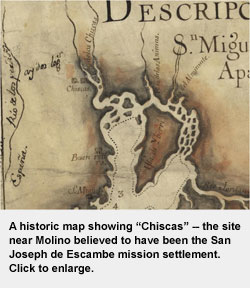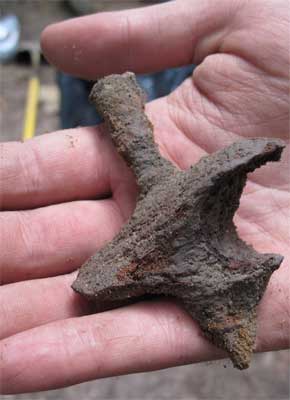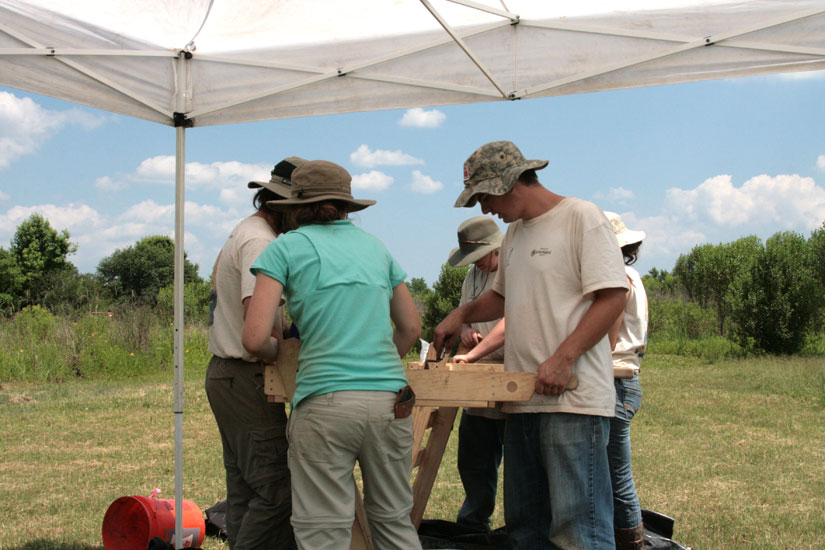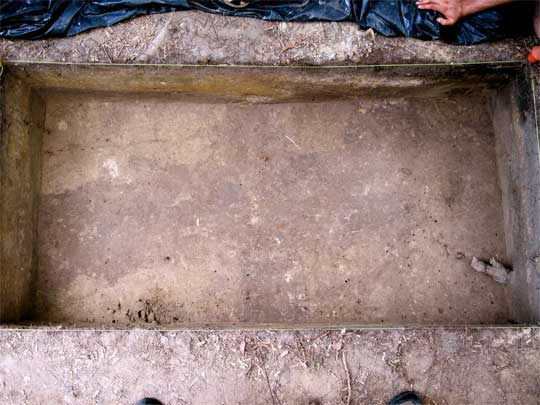Escambia’s Roots Found In Molino; UWF Uncovers Historical Site
August 9, 2009
Escambia’s roots have been uncovered in Molino, along with evidence of habitation thousands of years ago.
The University of West Florida archaeological field school has wrapped up a successful summer dig last week, uncovering evidence of the San Joseph De Escambe Spanish mission dating back to the 18th century in Molino.
 The Mission San Joseph De Escambe was established upriver along the Escambia River — which, along with Escambia County, actually took its later name from the mission near Molino. The Apalachee Indian settlement with about 75 residents is well documented, according to archaeologist John Worth. It was established in the 1740’s. A Franciscan missionary was stationed by the Spanish at the village along with 15 members of a Spanish cavalry unit until about 1757.
The Mission San Joseph De Escambe was established upriver along the Escambia River — which, along with Escambia County, actually took its later name from the mission near Molino. The Apalachee Indian settlement with about 75 residents is well documented, according to archaeologist John Worth. It was established in the 1740’s. A Franciscan missionary was stationed by the Spanish at the village along with 15 members of a Spanish cavalry unit until about 1757.
The village was led by Apalachee Chief Juan Marcos Fant until it was destroyed during a Creek Indian raid on April 9, 1761. The village and the church were at least partially burned during the raid. Following the raid, the residents moved down the Escambia River to what is now downtown Pensacola.
The mission was uncovered by the UWF archeology students under the leadership professor Dr. John Worth. Worth spent years digging through historical records before the actual digging in Molino began.
The missions settlement is believed to have included a Spanish missionary church and a small Apalachee Indian village. Evidence of the buildings was discovered during the summer field school, including a wall that appears to have been a post-on-sill construction type that was commonly used on French colonial sites. It has also been documented in Pensacola’s Spanish presidios. UWF archeologists said the Molino site also included an apparent floor structure on the inside of the building.
 While the walls have deteriorated over time and appear to the casual observer to be nothing more than darker soil, UWF students found almost 40 wrought iron nails in their original positions. In what was called an “amazing” find, students uncovered a wrought iron nail still embedded in piece of wood (pictured left), the remains of a beam or post where the nail was hammered about 250 years ago.
While the walls have deteriorated over time and appear to the casual observer to be nothing more than darker soil, UWF students found almost 40 wrought iron nails in their original positions. In what was called an “amazing” find, students uncovered a wrought iron nail still embedded in piece of wood (pictured left), the remains of a beam or post where the nail was hammered about 250 years ago.
One of the wall areas discovered was considered substantial, possibly part of the Spanish Calvary barracks or the actual mission church.
In addition to the 18th century Mission San Joseph De Escambe, UWF archeology students uncovered evidence of much earlier prehistoric life along the river in Molino. The oldest item found was a spear point dating between 1,200 and 3,900 B.C.
Friday was the final official day for the UWF field school, with students spending 14 hours wrapping up their research and filling holes. A few students will return next week to finish some final documentation and fill the remaining excavations.
The mission site was located near Yuhasz Road near Fairground Park. The entire site is on private property and is not open to the public.
For more information on the project, visit pensacolacolonialfrontiers.blogspot.com for the project blog. Also see two previous NorthEscambia.com articles:
- UWF Archeology Uncovers Possible Spanish Mission Evidence In Molino (July 21)
- UWF Digging For The Past In Molino; 2,000 Year Old Artifacts Found (June 29)
Pictured above: UWF Archeology students carefully sift through soil while they search for artifacts near Molino. Pictured bottom inset: A wrought iron nail in a fragment of wood from about 250 years ago. The excavation below shows evidence of two walls (the darker overlapping areas). NorthEscambia.com and courtesy photos, click to enlarge.
Comments
4 Responses to “Escambia’s Roots Found In Molino; UWF Uncovers Historical Site”





Congrats to Dr. Worth and his team.
Great job UWF.
Will any of the findings go on display on campus in the future?
What a story! I am so glad UWF did this dig and that William followed up on it. The Fant name is well known in the Molino area. Hope someone in the family sees this. They may not be related but it’s great reading anyway. GOOD JOB!
+1 к предыдущему комменту
Hey you guys!! Great job. This has been so interesting. Your blog is great too. Thanks for sharing all the details. We hate to see you go.